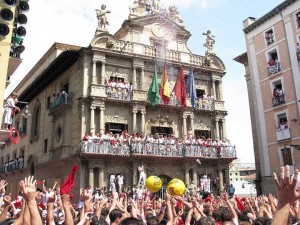July gets closer and the Spanish city Pamplona starts getting ready for the most important festivity of the year, the Sanfermines, a festivity in honour of San Fermin. These festivities are very well known on international level and attract people from all over the world, that’s why it becomes a big opportunity for Spanish students to enjoy one of the most representative festivities in Spain.
The festivity starts on the 6th of July at 12 noon with the chupinazo from the town hall balcony, like every popular festivity everything starts with the launch of the fireworks. The chupinazo together with the sentence “Pamploneses, Pamplonesas ¡Viva San Fermín! ¡Gora San Fermín!” (Pamploneses, Viva San Fermín!) turns into one of the pillars of the festivities, and then start all shows and events.
The most famous and spectacular activity in the Sanfermines is the encierros, a race in front of or accompanied by a herd of bulls and leading bulls which starts at eight in the morning. They cover all the old Pamplona streets and finish on the “plaza de toros”, which is a total of895 meterslong. The encierros take place from the 7th until the 14th of July, and it is a dangerous activity that counts with a great tourist and Pamplona citizens participation. Before they start to run the encierro all participants sing the Prego a San Fermín, a canticle to ask him for help:”A San Fermín pedimos por ser nuestro patrón, nos guíe en el encierro dándonos su bendición. Viva San Fermín! Viva! Gora San Fermin! Gora!”.
(To San Fermin we ask for being our patron saint, he guide us in the encierra giving us his benediction…)
Other activities take place in the city during the festivities, the famous Riau-Riau, which is a route between the town house and the San Lorenzo church where thousands of people sing and dance the waltz “La Alegría de san Fermín”(San Fermin happiness); the group of giants and cabezudos (figures with large heads), the festivities’ symbols; the fireworks, the fire bull or the encierro of the villavesa, among many other activities.
Spanish students have to know that to go to the Sanfermines they need to be dressed with the traditional festivity clothes, the T shirt and trousers have to be white. A red wide belt and a neckerchief has to be worn on the wrist, which has to be tied around the neck after the chupinazo, never before. They also need to know and sing the festivities’ Official Anthem at all times:
“Uno de enero, dos de febrero, tres de marzo, cuatro de abril, cinco de mayo, seis de junio, siete de julio, ¡SAN FERMÍN! Uno de enero, dos de febrero, tres de marzo, cuatro de abril, cinco de mayo, seis de junio, siete de julio, ¡SAN FERMÍN! A Pamplona hemos de ir, con una media, con una media, a Pamplona hemos de ir con una media y un calcetín”
(First of January, second of February, third march, fourth of April, fifth of may, sixth of June, seventh of July, San Fermin!… To Pamplona we have to go, with a tight, with a tight, to Pamplona we have to go with a tight and a sock)
The festivities finish at midnight on the 14th of July on the city’s town house square, where thousands of citizens sing the farewell song with great sadness.
“Pobre de mí, pobre de mí, que se han acabado las fiestas de San Fermín. Pobre de mí, pobre de mí, que se han acabado las fiestas de San Fermín”.
(Poor me, poor me, the San Fermín festivities came to an end…)
Image chupinazo. Pablo Izquierdo. http://bit.ly/lRFuI7
Image running of the bulls. Alvaro Barrientos. http://bit.ly/kOynro















